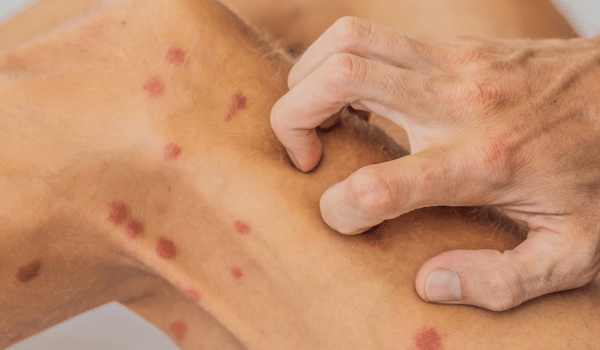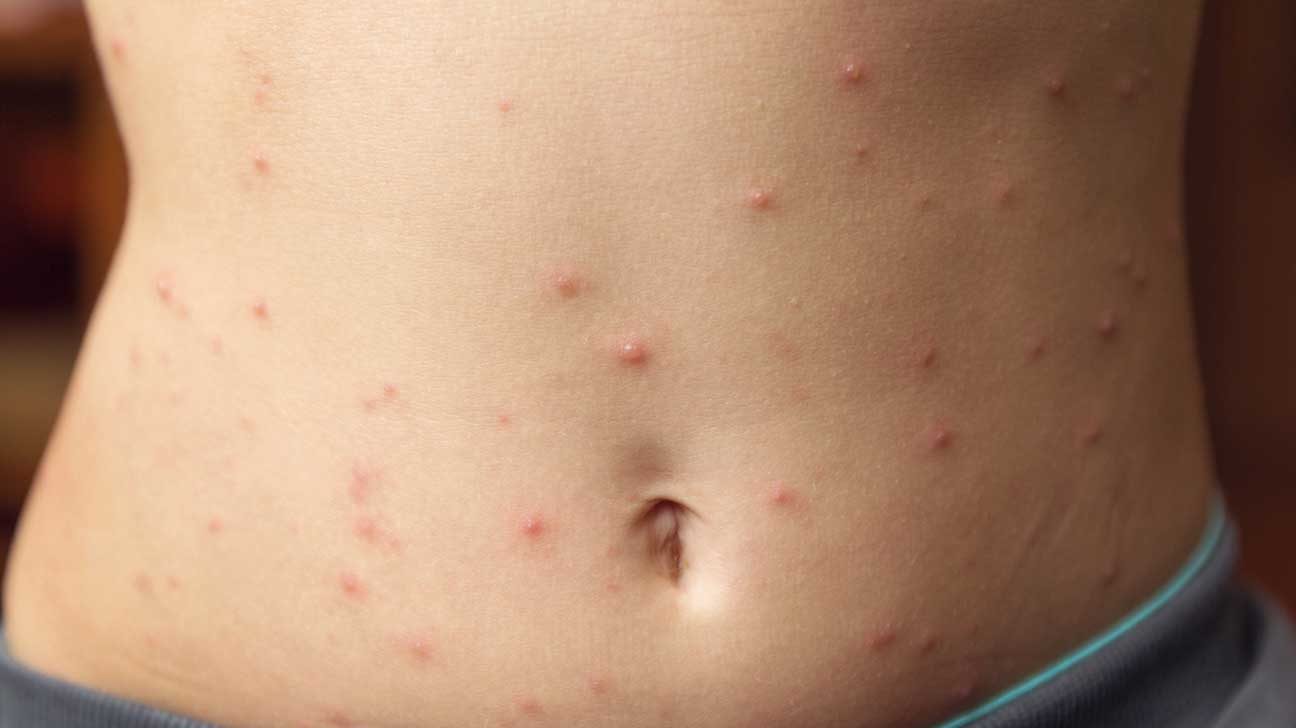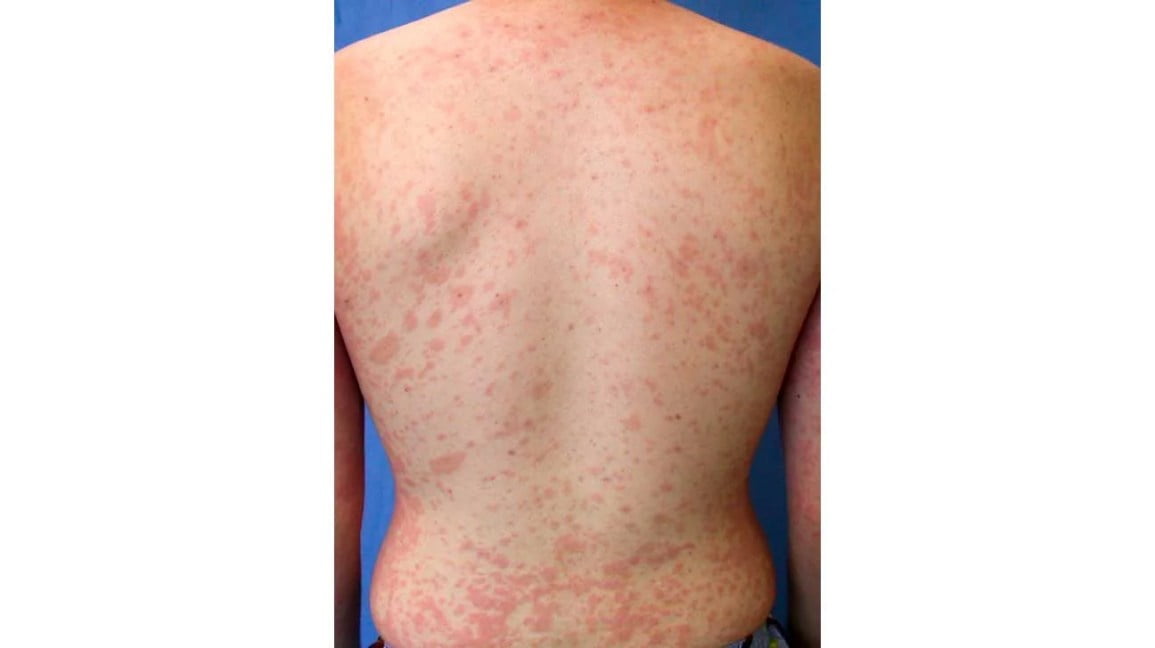Itching red spots on the whole skin can be caused by various factors, including allergies, insect bites, heat rash, eczema, or an autoimmune disorder. These conditions result in inflammation and irritation of the skin, leading to the appearance of red, itchy spots.
Identifying the root cause of the itching red spots is crucial to determine the appropriate treatment and relief for this condition. Understanding the underlying causes can help individuals take necessary precautions and seek proper medical attention to alleviate their symptoms and prevent further complications.
We will explore the common causes of itching red spots on the whole skin and provide insights into their symptoms and treatment options.

Credit: www.healthline.com
Common Causes Of Itching Red Spots
Itching red spots on the skin can be caused by various factors such as allergies, insect bites, eczema, or contact dermatitis. Other common causes include heat rash, psoriasis, and infections like scabies or chickenpox. Identifying the specific cause of the red spots is crucial for effective treatment.
Allergic Reactions
Allergic reactions are a common cause of itching red spots on the skin. When our immune system overreacts to substances that are normally harmless, such as certain foods, medications, or environmental factors, it can lead to a range of symptoms, including the appearance of red spots that itch intensely.
Allergens:
- Insect bites
- Pollen
- Dust mites
- Animal dander
- Mold spores
- Certain medications
- Foods such as peanuts, shellfish, or dairy
When exposed to these allergens, your body releases histamine, a chemical that causes the blood vessels to dilate and become more permeable. This leads to the characteristic red spots and itching sensation that often accompany an allergic reaction.
Insect Bites
Insect bites are another common cause of itching red spots on the skin. Mosquitoes, bedbugs, fleas, and ticks are just a few of the pesky critters that can leave behind itchy red bumps that can be extremely bothersome.
Types of Insect Bites:
- Mosquito bites
- Bedbug bites
- Flea bites
- Tick bites
- Spider bites
When an insect bites, it injects saliva into your skin, which often contains substances that can trigger an immune response. This immune response leads to inflammation and itching, causing the red spots to appear.
Skin Conditions
Various skin conditions can also be responsible for those persistent itching red spots that affect our skin. These conditions can range from mild to severe and may require medical attention for proper treatment and relief.
Examples of Skin Conditions:
- Atopic dermatitis (eczema)
- Psoriasis
- Urticaria (hives)
- Scabies
- Fungal infections (such as ringworm)
These skin conditions often present with red spots that may be accompanied by flakes, scales, rashes, or blisters. The itching can be intense and persistent, making it crucial to seek appropriate treatment to alleviate symptoms.
Symptoms And Identification
Itching red spots can appear on the whole skin, causing discomfort and concern. Identifying the symptoms associated with these spots is crucial in determining the underlying cause. By recognizing the common signs, one can take appropriate measures for prevention and treatment.
Types Of Rashes
When it comes to itching red spots, various types of rashes can be responsible. It is essential to understand these rashes and their characteristics for better identification. Some common types include:
- Atopic Dermatitis: This chronic, itchy rash often begins in childhood and may be accompanied by dry skin and a family history of allergies or asthma.
- Urticaria: Also known as hives, this rash presents as raised, itchy welts that can change size and shape in different areas of the body.
- Psoriasis: Characterized by thick, red patches of skin covered with silvery scales, this chronic autoimmune condition can cause itching and discomfort.
- Contact Dermatitis: This rash occurs when the skin comes into contact with an irritant or allergen, resulting in redness, itching, and sometimes blisters.
- Scabies: Caused by mites burrowing into the skin, scabies rash often appears as small red bumps or blisters, accompanied by intense itching, especially at nighttime.
Accompanying Symptoms
Identifying the distinctive symptoms accompanying itching red spots can provide valuable clues for diagnosis. Some commonly associated symptoms include:
- Burning or stinging sensation
- Swelling or inflammation of the affected area
- Skin dryness or peeling
- Pain or tenderness
- Formation of blisters or crusts
- Fever or general malaise (in certain cases)
Recognizing these accompanying symptoms in conjunction with the appearance of itching red spots assists healthcare professionals in determining the cause and implementing appropriate treatment options.
Treatment Options
If you’re dealing with itching red spots on your skin, it’s essential to explore treatment options to find relief. There are various approaches to consider, including topical treatments, oral medications, and home remedies. Depending on the cause and severity of your symptoms, one or more of these options may be recommended by your healthcare professional.
Topical treatments are commonly used to alleviate itching and redness on the skin’s surface. These medications are applied directly to the affected areas and can provide immediate relief. Here are a few examples of topical treatments:
- Corticosteroid creams or ointments help reduce inflammation and control itching.
- Antihistamine creams or lotions can counteract allergic reactions and relieve itching.
- Calamine lotion has a soothing effect on the skin and helps reduce itching and redness.
- Topical antibiotics are used if the itching spots are caused by a bacterial infection.
It’s crucial to follow the instructions provided by your healthcare professional or read the product label carefully when using these topical treatments. Ensure you apply the medication only to the affected areas and avoid any contact with open wounds or broken skin.
In some cases, oral medications may be prescribed to treat itching red spots that are widespread or resistant to topical treatments. These medications work from within to address the underlying causes and alleviate symptoms. Here are a few examples of oral medications:
- Antihistamines help in reducing itching and minimizing allergic reactions.
- Steroids may be prescribed for severe cases to reduce inflammation and itching.
- Prescription-strength antibiotics are used for treating bacterial infections.
- Immunosuppressants can be prescribed for conditions where the immune system plays a role in the symptoms.
It’s important to take oral medications exactly as prescribed and follow the instructions provided by your healthcare professional. Do not exceed the recommended dosage and be aware of any potential side effects associated with these medications.
In addition to medical treatments, there are various home remedies that can help alleviate itching red spots on the skin. These remedies may provide temporary relief and can be used in conjunction with other treatments. Here are a few examples:
- Avoid scratching the affected areas to prevent further irritation and potential infection.
- Apply cold compresses or ice packs to reduce itching and inflammation.
- Take lukewarm baths with colloidal oatmeal or baking soda to soothe the skin.
- Use fragrance-free and gentle cleansers and moisturizers to avoid aggravating the skin.
- Avoid exposure to known allergens or irritants that may trigger the symptoms.
It’s important to note that home remedies may not provide complete relief or treat the underlying cause of your symptoms. Consult with your healthcare professional to determine the most appropriate course of action.

Credit: www.vucare.com
Prevention And Care
Preventing and caring for itching red spots on your whole skin is crucial for maintaining skin health and alleviating discomfort. By avoiding triggers and establishing a suitable skincare routine, you can effectively manage and reduce the occurrence of these irritating spots.
Avoiding Triggers
Identifying and avoiding triggers is the first step towards preventing itching red spots on your skin. Here are some common triggers to be mindful of:
- Tight Clothing: Opt for loose-fitting garments to allow your skin to breathe and minimize irritation.
- Harsh Soaps and Detergents: Choose gentle, fragrance-free products formulated for sensitive skin.
- Hot Showers: Limit your shower time and use lukewarm water to avoid drying out your skin.
- Excessive Heat or Cold: Protect your skin from extreme temperatures by dressing appropriately and using moisturizers.
- Environmental Allergens: Try to avoid exposure to pollen, pet dander, and other allergens that may trigger a reaction.
Skin Care Routine
Establishing a regular skincare routine can help prevent and manage itching red spots on your whole skin. Follow these tips for a healthy skin care regimen:
- Keep Your Skin Moisturized: Apply a non-comedogenic moisturizer daily to keep your skin hydrated and reduce dryness.
- Use Mild Cleansers: Choose gentle cleansers specifically designed for your skin type to avoid further irritation.
- Avoid Scratching: Although it may be tempting, scratching can worsen itching and lead to potential infections. Use hydrocortisone creams or take over-the-counter antihistamines to relieve itching.
- Protect Your Skin from the Sun: Apply a broad-spectrum sunscreen with at least SPF 30 and wear protective clothing and accessories to shield your skin from harmful UV rays.
- Manage Stress Levels: Stress can exacerbate skin conditions. Engage in stress-reducing activities such as exercise, meditation, or hobbies to promote overall well-being.
Taking these preventive measures and establishing a suitable skin care routine can significantly improve the health of your skin and minimize the occurrence of itching red spots. If symptoms persist or worsen, it’s always advisable to consult with a dermatologist for further evaluation and personalized treatment options.

Credit: www.healthline.com
Frequently Asked Questions On What Causes Itching Red Spots On The Whole Skin?
What Are The Common Causes Of Itching Red Spots On The Skin?
Itching red spots can be caused by allergic reactions, insect bites, or skin conditions such as eczema or psoriasis. Other causes may include stress, medications, or infections.
How Can I Relieve Itching From Red Spots On My Skin?
You can relieve itching by applying a cold compress, using over-the-counter anti-itch creams, taking an oatmeal bath, or using aloe vera gel. It’s important to avoid scratching the affected area to prevent further irritation.
When Should I Consult A Doctor About Itching Red Spots On My Skin?
If the itching and red spots persist for more than a few weeks, are accompanied by other symptoms, or are causing significant discomfort, it’s important to consult a healthcare professional for proper diagnosis and treatment.
Conclusion
Understanding the causes of itching red spots on the skin is crucial for effective treatment. Whether it’s due to allergies, insect bites, or skin conditions, identifying the underlying cause is the key to finding relief. Consulting with a healthcare professional can help determine the right course of action and provide tailored solutions.
Maintaining good hygiene, using suitable skincare products, and avoiding potential triggers can also contribute to healthier skin. Stay informed, take necessary precautions, and prioritize your skin’s well-being.
